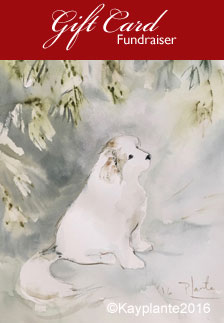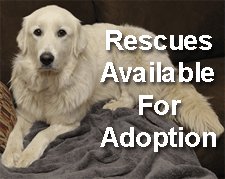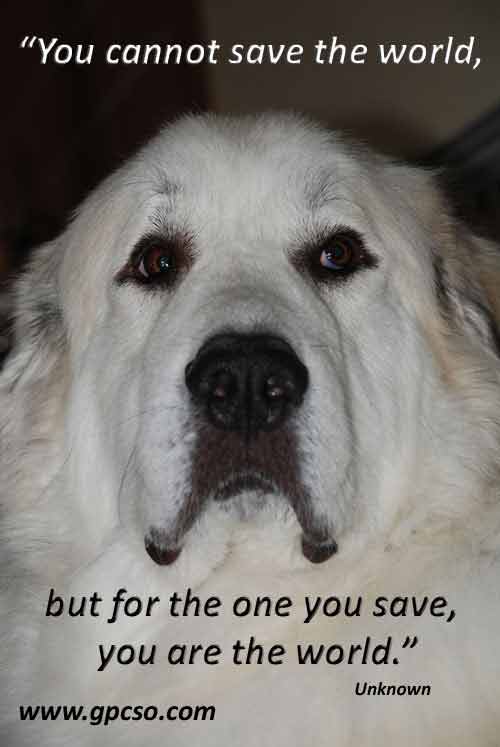Great Pyrenees Breed Standard
We are pleased to provide the official Great Pyrenees Breed Standard provided by the Canadian Kennel Club (CKC). The Great Pyrenees Club of Southern Ontario extends its thanks to the Canadian Kennel Club (CKC) for their generosity and kind permission for its use.
The Great Pyrenees Breed Standard is an important tool to assist in maintaining and assessing the conformation of the breed both in appearance and temperament. It is the standard by which Great Pyrs are judged and is essential in maintaining the purity of the breed.
We have provided the Great Pyrenees Breed Standard as a PDF document, which you can download, and use for future reference. You will find the link at the bottom of this page. Use it to help in the selection of your next Great Pyrenees or to simply enhance your understanding and appreciation of this wonderful breed.
Canadian Kennel Club Official Great Pyrenees Breed Standard
General Appearance
The Great Pyrenees dog conveys the distinct impression of elegance and unsurpassed beauty combined with great overall size and majesty. He has a white or principally white coat that may contain markings of badger, grey, or varying shades of tan. He possesses a keen intelligence and a kindly, while regal, expression. Exhibiting a unique elegance of bearing and movement, his soundness and coordination show unmistakably the purpose for which he has been bred, the strenuous work of guarding the flocks in all kinds of weather on the steep mountain slopes of the Pyrenees.
Size
The height at the withers ranges from 27 inches to 32 inches (69 - 81 cm) for dogs, and from 25 inches to 29 inches (64 - 74 cm) for bitches. A 27 inch dog weighs about 100 pounds (45 kg) and a 25 inch bitch weighs about 85 pounds (37 kg). Weight is in proportion to the overall size and structure.
Proportion
The Great Pyrenees is a balanced dog with the height measured at the withers being somewhat less than the length of the body measured from the point of the shoulder to the rearmost projection of the upper thigh (buttocks). These proportions create a somewhat rectangular dog, slightly longer than it is tall. Front and rear angulation are balanced.
Substance
The Great Pyrenees is a dog of medium substance whose coat deceives those who do not feel the bone and muscling. Commensurate with this size and impression of elegance, there is sufficient bone and muscle to provide a balance with the frame.
Faults
Size
Dogs and bitches under minimum size or over maximum size.
Substance
Dogs too heavily boned or too lightly boned to be in balance with their frame.
Head
Correct head and expression are essential to the breed. The head is not heavy in proportion to the size of the dog. It is wedge-shaped with a lightly rounded crown.
Expression
The expression is elegant, intelligent and contemplative.
Eyes
Medium sized, almond shaped, set slightly obliquely, rich dark brown. Eyelids are close fitting with black rims.
Ears
Small to medium in size, V-shaped with rounded tips, set on at eye level, normally carried low, flat, and close to the head. There is a characteristic meeting of the hair of the upper and lower face which forms a line from the outer corner of the eye to the base of the ear.
Skull and Muzzle
The muzzle is approximately equal in length to the back skull. The width and the length of the skull are approximately equal. The muzzle blends smoothly with the skull. The cheeks are flat. There is sufficient fill under the eyes. A slight furrow exists between the eyes. There is no apparent stop. The bony eyebrow ridges are only slightly developed. Lips are light fitting with the upper lip just covering the lower lip. There is a strong lower jaw. The nose and lips are black.
Teeth
A scissor bite is preferred, but a level bite is acceptable. It is not unusual to see dropped (receding) lower central incisor teeth.
Faults
- Too heavy head (St. Bernard or Newfoundland-like).
- Too narrow or small skull.
- Foxy appearance.
- Presence of an apparent stop.
- Missing pigmentation on nose, eye rims, or lips.
- Eyelids - round, triangular, loose or small.
- Overshot, undershot, wry mouth.
Neck
Strongly muscled and of medium length, with minimal dewlap.
Topline
The backline is level.
Body
The chest is moderately broad. The rib cage is well sprung, oval in shape, and of sufficient depth to reach the elbows. Back and loin are broad and strongly coupled with some tuckup. The croup is gently sloping with the tail set on just below the level of the back.
Tail
The tailbones are of sufficient length to reach the hock. The tail is well plumed, carried low in repose and may be carried over the back, “making the wheel” when aroused. When present, a “shepherd’s crook” at the end of the tail accentuates the plume. When gaiting, the tail may be carried either over the back or low. Both carriages are equally correct.
Fault
Barrel ribs.
Forequarters
Shoulders - The shoulders are well laid back, well muscled, and lie close to the body. The upper arm meets the shoulder blade at approximately a right angle. The upper arm angles backward from the point of the shoulder to the elbow and is never perpendicular to the ground. The length of the shoulder blade and the upper arm are approximately equal. The height from the ground to the elbow appears approximately equal to the height from the elbow to the withers.
Forelegs
The legs are of sufficient bone and muscle to provide a balance with the frame. The elbows are close to the body and point directly to the rear when standing and gaiting. The forelegs, when viewed from the side, are located directly under the withers and are straight and vertical to the ground. The elbows, when viewed from the front, are set in a straight line from the point of shoulder to the wrist. Front pasterns are strong and flexible. Each foreleg carries a single dewclaw.
Front Feet
Rounded, close-cupped, well padded, toes well arched.
Hindquarters
The angulation of the hindquarters is similar in degree to that of the forequarters.
Thighs
Strongly muscular upper thighs extend from the pelvis at right angles.The upper thigh is the same length as the lower thigh, creating moderate stifle joint angulation when viewed in profile. The rear pastern (metatarsus) is of medium length and perpendicular to the ground as the dog stands naturally. This produces a moderate degree of angulation in the hock joint, when viewed from the side. The hindquarters from the hip to the rear pastern are straight and parallel, as viewed from the rear. The rear legs are of sufficient bone and muscle to provide a balance with the frame. Double dewclaws are located on each rear leg.
Rear Feet
The rear feet have a structural tendency to toe-out slightly. This breed characteristic is not to be confused with cow-hocks. The rear feet, like the fore feet, are rounded, close-cupped, well padded with toes well arched.
Faults
Absence of double dewclaws on each rear leg.
Coat
The weather resistant double coat consists of a long, flat, thick, outer coat of coarse hair, straight or slightly undulating, and lying over a dense, fine, woolly undercoat. The coat is more profuse about the neck and shoulders where it forms a ruff or mane which is more pronounced in males. Longer hair on the tail forms a plume. There is feathering along the back of the front legs and along the back of the thighs, giving a “pantaloon’ effect. The hair on the face and ears is shorter and of finer texture. Correctness of coat is more important than abundance of coat.
Faults
Curly coat. Stand-off coat (Samoyed type)
Colour
White or white with markings of grey, badger, reddish brown, or varying shades of tan. Markings of varying size may appear on the ears, head (including a full face mask), tail, and as a few body spots. The undercoat may be white or shaded. All of the above described colourings and locations are characteristic of the breed and equally correct.
Faults
Outer coat markings covering more than one third of the body.
Gait
The Great Pyrenees move smoothly and elegantly, true and straight ahead, exhibiting both power and agility. The stride is well balanced with good reach and strong drive. The legs tend to move toward the center line as speed increases. Ease and efficiency of movement are more important than speed.
Temperament
Character and temperament are of utmost importance. In nature, the Great Pyrenee is confident, gentle, and affectionate. While territorial and protective of his flock or family when necessary, his general demeanor is one of quiet composure, both patient and tolerant. He is strong willed, independent and somewhat reserved, yet attentive, fearless and loyal to his charges both human and animal.
Fault
Although the Great Pyrenees may appear reserved in the show ring, any sign of excessive shyness, nervousness, or aggression to humans, is unacceptable and must be considered an extremely serious fault.
Print A Copy Of The Great Pyrenees Breed Standard Here
If you would like to print a copy of the Great Pyrenees Breed Standard as published by the Canadian Kennel Club, you can use the link below. Please note that you will need ADOBE Acrobat Reader to read the document.
Download the Great Pyrenees Breed Standard here.
Return to the Home Page from the Great Pyrenees Breed Standard.
Breaking News
-
Courtesy Post - Sarge
Dec 05, 25 10:10 AM
Courtesy Post - Sarge Location: Mount Albert, Ontario DoB: Unknown 2023 Required: He is comfortable around livestock, but he will go as a companion -
Hardy
Nov 25, 25 02:42 PM
Hardy Location: Acton, ON DOB: Approx. January 2025 (we think he is older though) Single-family home required. Minimum 5-foot securely fenced yard. -
Ronnie
Nov 22, 25 06:20 AM
*Adopted* Location: Acton, ON DOB: 9-years-old This big sweetheart went to foster and was soon adopted before we got him posted. From the shelter: -
Bo
Nov 19, 25 12:04 PM
DOB: late Sept 2023 (don’t know for sure) rescued Dec 2023 Location: Acton, Ontario Name: Bo Single dwelling home with a securely fenced yard of at -
Lola
Nov 19, 25 12:01 PM
*ADOPTED* A single family dwelling and a securely fenced yard of at least 5 feet are musts. DOB approx: Februay 12, 2021 Location: Acton, Ontario This -
Mayne
Nov 07, 25 04:04 PM
*ADOPTED* (FOSTER FAIL) Mayne Location: Acton, ON DOB: August 5, 2017 (8-years-old) Single-family home required. Minimum 5-foot securely fenced yard. -
Courtesy Post - Remi
Oct 17, 25 11:09 AM
*ADOPTED* Remi (Retriever/Pyr cross) D.o.B: Sept. 30, 2023 Location: Between Owen Sound and Port Elgin (Tara, ON) Remi was given up because of health -
Courtesy Post - Virgil
Sep 30, 25 01:03 PM
*ADOPTED* DoB of Virgil: 2021 (4.5 years old) Reason for rehoming this big white fluffy: Owner has passed away and he is presently living in an apartment.
















